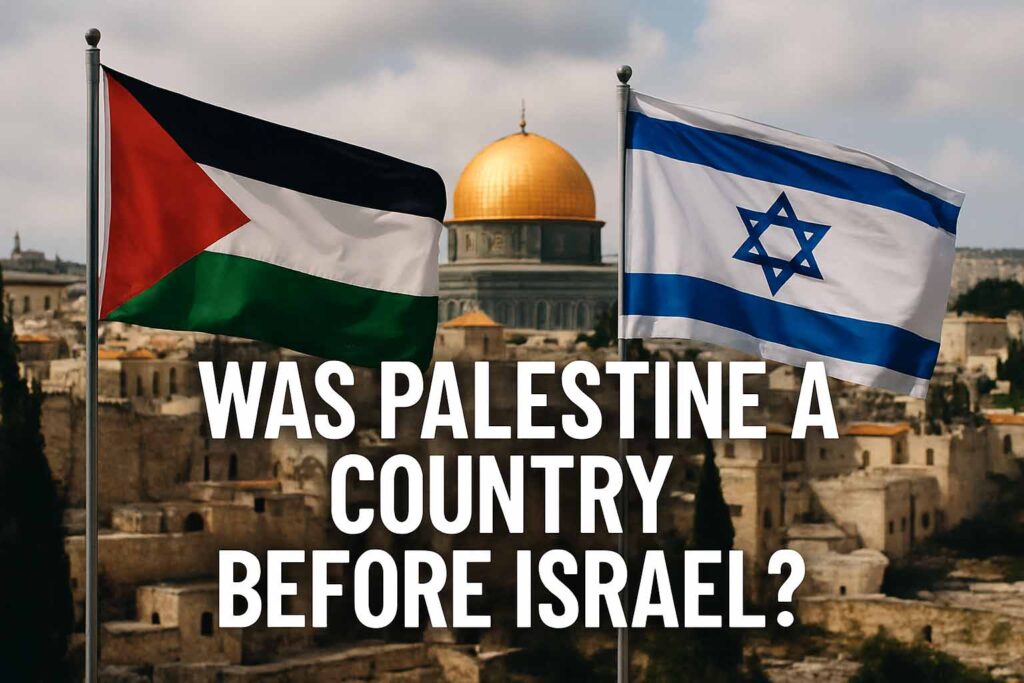Before the state, the mandate, and the endless debates, there was… well, it’s complicated.
The Oversimplified Version (If You’re in a Hurry)
TL;DR:
Before it was Israel, the land was called Mandatory Palestine, a territory managed by the British after the Ottoman Empire fell apart in World War I. It was home to a diverse population of Arabs (Muslim and Christian) and Jews, and the British made a royal mess of things by making conflicting promises to everyone.
What Actually Happened:
- Ancient Times & The Ottomans: After a long and complicated history involving everyone from the Romans to various caliphates, the region spent 400 years (1517-1917) as part of the Ottoman Empire. For centuries, different religious communities coexisted there in relative peace.
- World War I Upends Everything: The Ottomans sided with Germany in WWI and lost. Britain, wanting to gain an edge, made conflicting promises: they encouraged an Arab Revolt with vague suggestions of independence and also issued the 1917 Balfour Declaration, supporting a “national home for the Jewish people” in Palestine.
- The British Mandate (1920-1948): The League of Nations put Britain in charge of the region, officially called Mandatory Palestine. Its job was to govern the territory and prepare it for independence. During this period, Jewish immigration, driven by Zionism and persecution in Europe, increased dramatically.
- Tensions Boil Over: With both Arab and Jewish nationalist movements on the rise and competing for the same land, conflict became inevitable. Riots and revolts erupted. Overwhelmed and exhausted after WWII, Britain tossed the problem to the newly formed United Nations.
Why It Mattered:
This period set the stage for everything that followed. The political decisions, the demographic shifts, and the escalating violence during the British Mandate are the direct prequel to the 1948 war and the conflict that continues today.
Bonus Fun Fact:
During the Mandate period, the term “Palestinian” wasn’t exclusive to Arabs. It could refer to anyone living in the territory, including Jews and Christians. The prominent Jewish-run newspaper was called The Palestine Post before it was renamed The Jerusalem Post.
Oversimplified Rating: 🤯🤯🤯🤯🤯 International Hot Mess Level
The Real Story Is Always More Complicated
A Land Ruled by Many, Owned by None
Long before the 20th century, the strip of land between the Jordan River and the Mediterranean Sea was a well-trodden battleground and a crossroads for empires. It was passed between Assyrians, Babylonians, Persians, Greeks, Romans, and various Islamic caliphates. For the four centuries leading up to World War I, it was a relatively quiet corner of the Ottoman Empire.
Under Ottoman rule, there was no single country called “Palestine.” The area was divided into several administrative districts (sanjaks), like the Sanjak of Jerusalem, which reported directly to Istanbul. The population was a mosaic: a majority of Muslim Arabs, a significant Christian Arab minority, and a smaller, long-established Jewish community. These groups lived together, sharing cities and towns, with a level of coexistence that would become unimaginable in later decades.
Here Come the British (with Conflicting Blueprints)
The Ottoman Empire’s defeat in WWI shattered the old world order. Britain and France, the victors, drew new lines on the map of the Middle East. In 1920, the League of Nations formally granted Britain the “Mandate for Palestine,” making it the temporary colonial administrator.
Britain’s job was a diplomatic nightmare from the start, largely because of promises it had made during the war:
- The McMahon-Hussein Correspondence (1915-1916): Britain courted Arab leaders, seeming to promise support for an independent Arab state in the region if they would revolt against the Ottomans. The Arabs believed this promise included Palestine.
- The Sykes-Picot Agreement (1916): A secret pact between Britain and France to carve up the Ottoman lands for themselves, which directly contradicted the promise of a unified Arab state.
- The Balfour Declaration (1917): A public statement by the British government supporting “the establishment in Palestine of a national home for the Jewish people,” with the crucial—and ambiguous—proviso that it should not “prejudice the civil and religious rights of existing non-Jewish communities.”
It was a geopolitical case of promising the same apartment to three different tenants. As Jewish immigration from Europe accelerated, fueled by the Zionist movement and the horrific rise of Nazism, the Arab population grew increasingly alarmed, fearing they would be displaced and lose their national identity. This fear sparked resistance, which in turn led to violence.
What Was Life Actually Like on the Ground?
Forget the myth of an empty desert. Mandatory Palestine was a society in motion. Cities like Jerusalem, Haifa, Jaffa, and Tel Aviv were vibrant centers of trade, culture, and politics. Jaffa was famous for its orange groves and newspapers, while the all-Jewish city of Tel Aviv grew rapidly beside it.
The economy was largely agricultural, with citrus exports as a key driver. However, there was a growing economic gap. The Jewish community, supported by Zionist organizations and capital from abroad, developed a separate, more industrialized economy. This disparity deepened the social and political divisions.
The population itself transformed rapidly. In 1922, a British census showed that Jews made up about 11% of the population. By 1946, large-scale immigration had increased that share to about one-third.
Debunking a Common Myth: “A Land Without a People for a People Without a Land”
This famous Zionist slogan was powerful and effective, but factually inaccurate. The land was not empty. In 1947, on the eve of partition, Palestine was home to about 1.2 million Arabs and 600,000 Jews. It had bustling cities, a political press, schools, cultural institutions, and a society with deep historical roots. Both communities had legitimate claims, histories, and aspirations tied to the same small piece of land. The tragedy was that these aspirations were seen as mutually exclusive.
The Final Act: The UN Steps In
By 1947, Britain could no longer control the escalating violence between Jewish militias and Arab fighters. Exhausted by war and admitting failure, it handed the “Palestine problem” over to the United Nations. The UN created a special committee that recommended partitioning the land into two states: one Arab and one Jewish. Jerusalem was designated to be an international city administered by the UN.
The proposed Jewish state was allocated 56% of the land, though the Jewish population was about one-third of the total and owned less than 7% of the land. The Jewish leadership accepted the plan. The Arab leadership and surrounding Arab states rejected it entirely.
On November 29, 1947, the UN General Assembly passed the partition resolution. Civil war broke out almost immediately. The British washed their hands of the matter and withdrew. On May 14, 1948, David Ben-Gurion declared the establishment of the State of Israel. The next day, armies from neighboring Arab countries invaded, and the 1948 Arab-Israeli War began.
🔍 Mini FAQ: What People Also Ask
Q: What country was in Israel before 1948?
A: There was no independent country. It was a territory called Mandatory Palestine, administered by Great Britain under a League of Nations mandate.
Q: Who lived in Palestine before 1948?
A: The population consisted of an Arab majority (mostly Muslim, but also a significant Christian minority) and a Jewish minority, along with smaller groups like the Druze and Bedouins.
Q: Was there a country of Palestine before Israel?
A: No. While “Palestine” has been a geographical name for the region for millennia, it was not a modern, independent country before 1948. It was a territory governed by foreign powers, most recently the Ottoman Empire and then Britain.
Q: Why did Britain get involved in Palestine?
A: After defeating the Ottoman Empire in WWI, Britain was given administrative control over Palestine by the League of Nations to govern the territory and prepare it for future self-rule.
Q: What was the Balfour Declaration?
A: A 1917 public statement from the British government that announced support for creating a “national home for the Jewish people” in Palestine.
Q: What was the 1947 UN Partition Plan?
A: It was a UN proposal to end the British Mandate and split Palestine into two independent states, one Arab and one Jewish, with Jerusalem to be an internationally administered city.
Q: Did Jews live in the area before 1948?
A: Yes. Jewish communities have lived in the land continuously for thousands of years. Modern Zionist-inspired immigration began in the 1880s and increased dramatically during the British Mandate.
Q: Who rejected the UN plan for two states?
A: The leadership of the Palestinian Arabs and the leaders of the surrounding Arab states rejected the 1947 Partition Plan.




No comment yet, add your voice below!